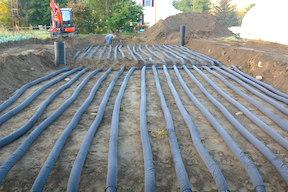
Jim Schultz built an HVAC system into his new high tunnel at Red Shirt Farm. Known as a climate battery, the system of underground pipes and fans helps heat plants in the winter and cool them in the summer.
“We’ve maintained temperatures around 40 F from October through February, sufficient for growing greens,” says Schultz. “We start the winter season with the soil temperatures around 79 F, and over the winter, it goes down. During the day, when the high tunnel temperatures get into the 60s, we run the fan to recharge the battery. At night, the fans pull the heat back out to warm the high tunnel.”
In western Massachusetts, the temperatures can reach -10 to -15 F. At that point, Schultz will supplement the battery with propane heaters. Fans are shut down. Supplemental heat is also used when tomatoes are transplanted into the high tunnel.
“We need 65 to 70 F for the tomatoes, so we shut down the fans and use propane heaters,” says Schultz.
In the summer, the fans are turned back on to pull hot, humid air through the series of pipes. Moisture is absorbed by the soil, and the temperature is lowered to the soil’s natural 45 F temperature.
“You can feel the reduction in humidity in the air exiting the climate battery,” says Schultz.
“With lower humidity in the high tunnel, we have fewer problems with disease, and we don’t see the moisture condensing on the plastic as we do in our other high tunnels.”
Schultz installed the climate battery with the aid of a grant when putting up a 30 by 72-ft. high tunnel. The first step was to remove topsoil in the footprint of the high tunnel, setting it aside. He then removed subsoil to a depth of 4 ft.
Following the design of a Colorado-based engineering firm, Schultz laid out three 30-ft., 12-in. poly culverts as manifolds. One was at either end of the excavation and one in the center. Three rows of 4-in. holes spaced at 4-ft. intervals were cut in the sides of the end manifolds, facing into the excavation. Three matching rows of holes were cut into each side of the center manifold. The manifolds were set at 30 ft. intervals.
The 4-ft. spacing was selected specifically for Schultz’s soil type. He notes that spacing in sandy/lighter soil could be closer, while heavier soil could have wider intervals as heat will transfer better in heavier soils.
Precut 30-ft. sections of 4-in. perforated drain tile with a sock were inserted in the lower row of holes in the three manifolds. Space between the pipes was then backfilled and compacted.
Once the process had been repeated twice, Schultz returned the topsoil in a 14-in. layer, sufficient for his preferred use of a broadfork to loosen the soil for transplants in his high tunnels.
The last step was to install 2-in. thick rigid foam boards around the perimeter of the excavation. He used two 2-ft. wide boards with one laid horizontal and a second set vertical facing the excavation.
“The combination of the two offers the same insulation against frost as a single vertical board going down 5 ft.,” explains Schultz.
Thermal curtains on the high tunnel add another layer of insulation. The curtains close automatically to help retain heat at night.
While the climate battery has been beneficial to Red Shirt Farm’s winter production, Schultz is unsure if he’ll repeat it in his next high tunnel. Planned use of a high tunnel is key to getting the full value out of the investment, suggests Schultz.
“The up-front cost is in the order of $10,000,” he says. “It’s best suited for winter growing. If you plan to use it only for peppers and tomatoes, it may not be the best decision. It’s great if you need cooling and dehumidifying in the summer, especially if you couple that with winter growing.”
Contact: FARM SHOW Followup, Red Shirt Farm, 60 Williamstown Rd., Lanesborough, Mass. 01237 (ph 413-822-9250; jim@redshirtfarm.com; www.redshirtfarm.com).
